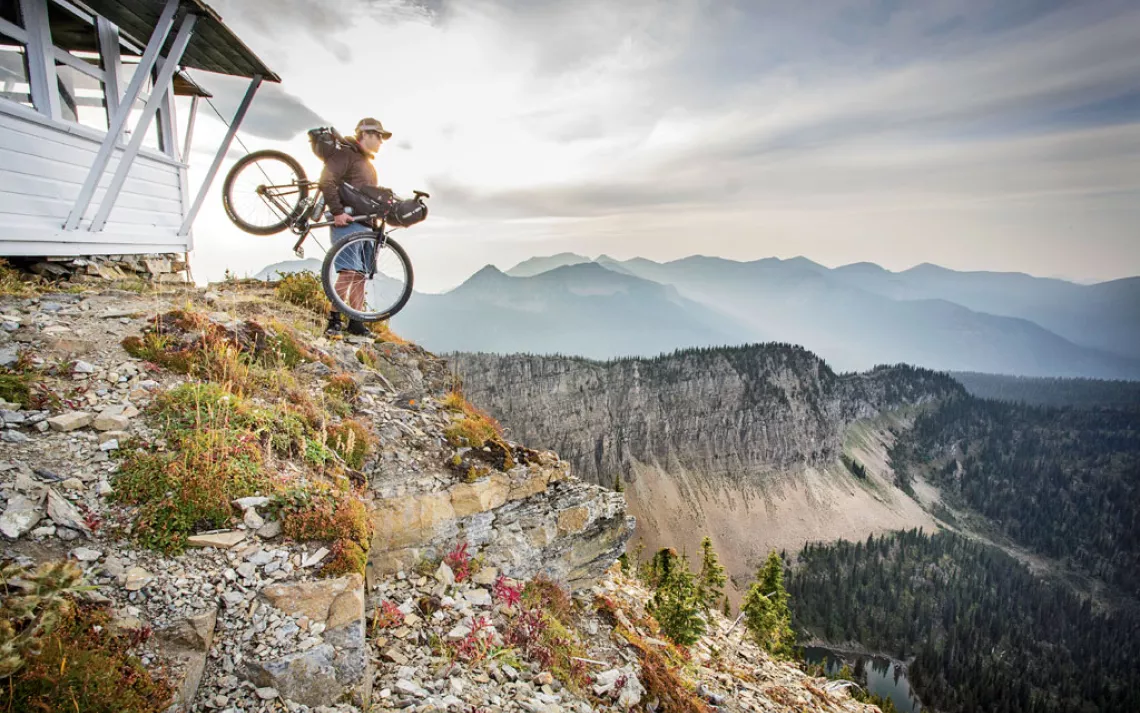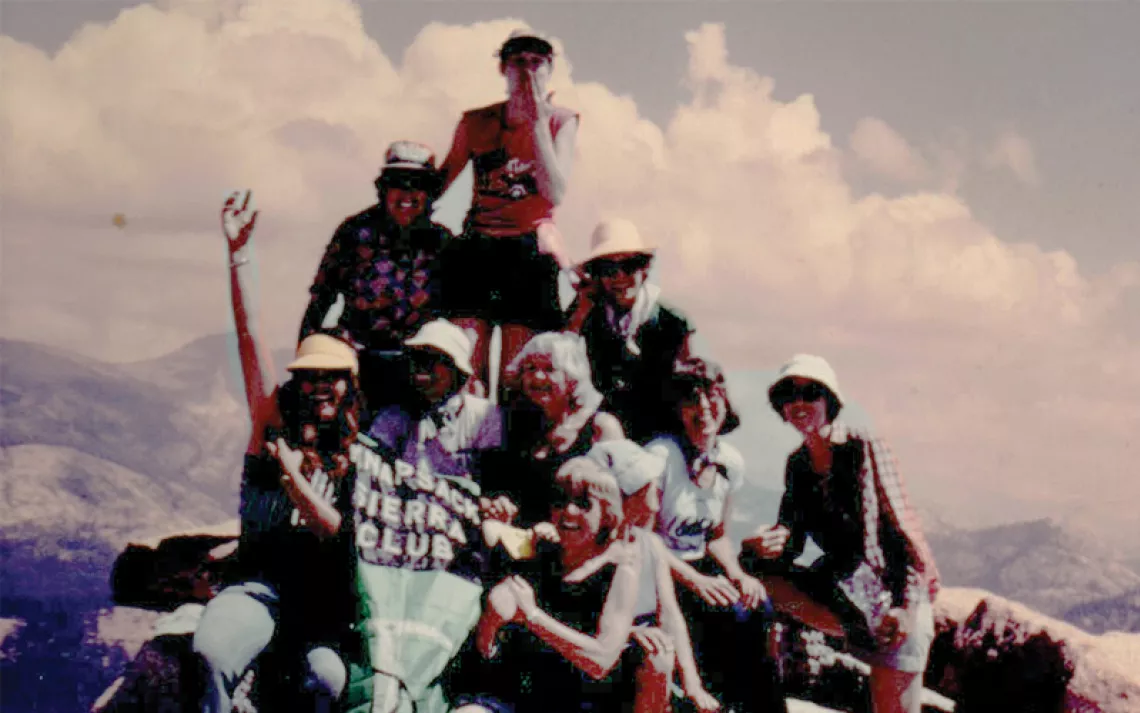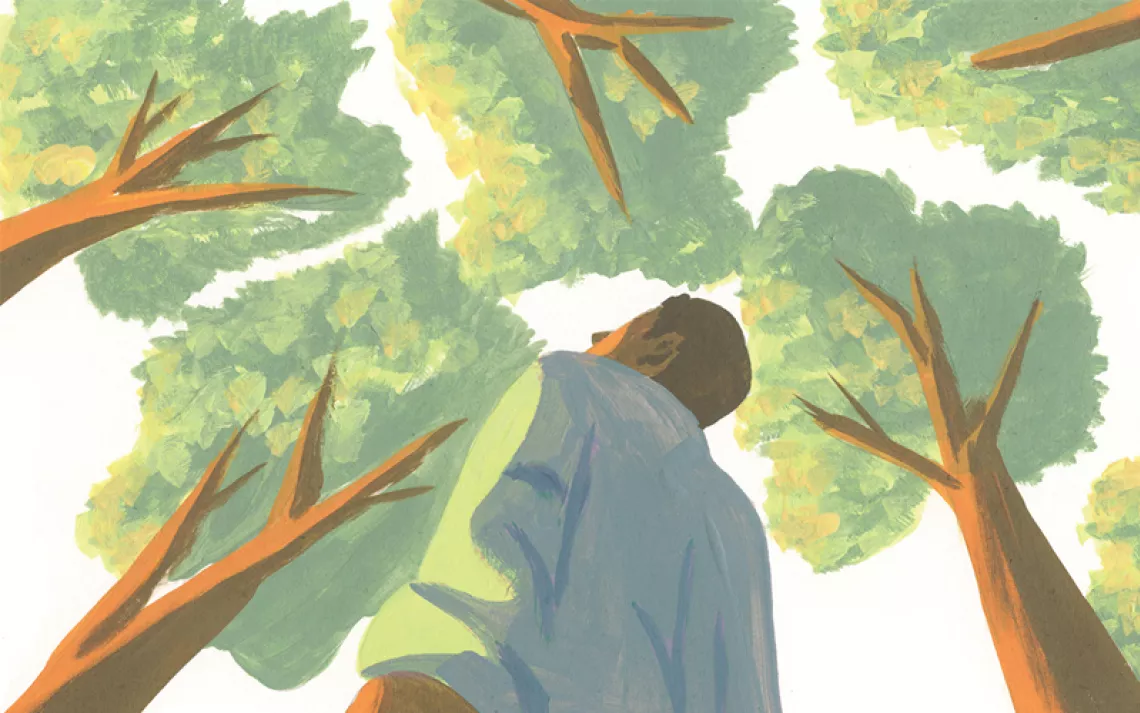We hadn't intended to start out so late in the day. Yet here we are, up a dirt road deep in the Yaak Valley in far northwestern Montana, with what looks like an entire REI store spread out before us. Instead of carefully packing, we'd simply hurled our gear into the car, and now we have to fit it in our bikepacks before we can pedal our mountain bikes up the steep, dead-end road.
We finally get going, but soon enough I have to stop and wait with Harold, my dad and longtime adventure partner, for his friend Ron, who is lagging. A New Yorker born and bred and a newcomer to cycling, Ron has a complicated relationship with wilderness. Even though he's joined us on mountain trips for decades, he's still not much for roughing it. And then there's his abiding fear of grizzly bears.
"Don't worry," I tell him. "Grizzlies never attack groups of three or more."
"We'd better stay together then," he says, "because the bear might not believe us if we tell it a third guy is coming."
Kinglets whistle from the lengthening shadows of ancient cedar and larch trees. We pound the pedals in a race against the setting sun, watching light climb the Percell Mountains until it ignites the sky's cirrus streaks. Ron points out the "chickens" by the roadside. In Montana, I tell him, we call them grouse.
The dirt road ends in a wall of trees. We push our bikes up a steep trail through the darkening forest until a square silhouette perched atop 30-foot stilts appears ahead of us on the mountain's broad summit—the Garver Mountain Lookout. We lean our bikes against the tower's supports in the last inkling of twilight. "And they say we don't plan," Dad says.
We ascend the lookout's Escher-esque staircase, the receding ground all too visible in our headlamp beams between the slats at our feet. This causes Ron to recall that, in addition to grizzlies, he is afraid of heights. His acrophobia will be tested—as will our cycling skills—in the days to come. Hikers in the Alps can wander from refuge to refuge cross-country skiers in the Sierra can ski hut-to-hut, but we are attempting something new: lookout-to-lookout mountain biking.

We unlock the lookout's door and light the lantern, illuminating 360 degrees of windows and a wood ceiling with real rope caulking around the joists. Ron approves. "Way nicer than a tent," he says.
I take the corner bunk, which is at the same height as the windows. The tower sways subtly in the wind as galaxies spin by outside. I feel like I'm falling asleep in a spaceship.
The Great Fire of 1910 killed 87 people and burned 3 million acres of forest in Idaho, Montana, and Washington. In its aftermath, the U.S. Forest Service resolved to never again be caught by surprise. It began building mountaintop lookouts, running telephone lines along the trails leading to them, and staffing them with hardy sentinels whose job was not only to spot fires but also to then hike cross-country to put them out. In the 1930s, the Civilian Conservation Corps took up the construction task, and soon there were 8,000 lookouts on summits across the country. The boom didn't last—in the decades following World War II, many were gradually abandoned. By the 1970s, the Forest Service was directing its districts to remove certain unused lookout towers for liability reasons.
In this remote pocket of the northern Rockies, however, the Kootenai National Forest quietly resisted those orders, starting to rent out four of its towers to the public in 1985. The program has grown over the years, and the Kootenai and its neighboring forests now boast more than 15 towers open to the public in an area three times the size of Yosemite National Park. It's the greatest density of rentable lookouts in the world.
Which makes it possible—in theory, at least—to tour them car-free, as we had hoped to do. But our last-minute planning made securing reservations in the proper sequence unworkable, so we had to resort to a vehicle to leapfrog roaded-over zones and get within biking distance of the most remote towers.
The next morning, I glass the surrounding mountains from the tower's wraparound balcony and find five other lookouts—Henry, Stahl Peak, Baldy, Baldy-Buckhorn, and Northwest Peak. We're staying at Garver for two nights, and our new worry is finding water, which can be a problem on mountaintops. Fortunately, after a few minutes of highly skilled exploration (and the discovery of a wooden sign reading "Spring"), we spot a trickle of water on the leafy forest floor of the mountain's east side. We toy with the idea of an ambitious day ride to the nearby ruins of an abandoned tower, but the magnetic pull of our view with a room is too strong to resist.
During the high-grade lounging that follows, we flip through the tower's logbook. Several writers complain about the steep hike up, as if lookout towers should be easy to reach. But mostly it's filled with comments from visitors praising God and/or Nature and finding renewal. One woman resolves to quit smoking—"right now!" These towers may have been built for utilitarian reasons, but they're also spiritual aeries. That's why they have their own literary tradition. Edward Abbey and Jack Kerouac both wrote about their summers in fire lookouts; Gary Snyder described his stay in "Mid-August at Sourdough Mountain Lookout":
I cannot remember things I once read
A few friends, but they are in cities.
Drinking cold snow-water from a tin cup
Looking down for miles Through high still air.
Or, as Norman MacLean wrote in his short story "USFS 1919: The Ranger, the Cook, and a Hole in the Sky," "It doesn't take much in the way of body and mind to be a lookout. It's mostly soul."
Which apparently Ron is short on. "I could never do this job," he says over breakfast. "Just sitting here all day looking out the windows."
So we wrest ourselves from our perch and head out for an afternoon ride on the trails that thread the surrounding high country. I dispense tips on navigating the tricky terrain as we swoop and twist through the columns of mossy lodgepole forest. The forest opens to a sun-drenched field where the smell of snowbrush fills the air and moose bones litter the trail side. A high point offers a view back to our tower, jutting above the wooded summit like a lighthouse rising from a sea of trees—surely the coolest lodging in the world.
I COULD HAVE SPENT WEEKS AT GARVER, but we have new towers to explore to the east. After grinning through the long descent to our car at the foot of the mountain, we pick the bugs out of our teeth and drive an hour and a half to the little logging town of Eureka in the Tobacco Valley, only 10 miles from the Canadian border. There, in the Historical Village parking lot, we meet my friend Casey Greene, who is something of a pioneer himself. A cartographer for the Adventure Cycling Association in Missoula, Casey was the first to see the potential of touring lookout towers by bike, something he'd tried out each of the past two summers. With Casey joining us, our plan is to head to a pair of remote towers in the mountains vaulting from the edge of town.
Pavement turns to dirt as we drive into the lower reaches of the Whitefish Range. After a few unsigned turns on old logging tracks, we reach a barely detectable trailhead marked by a weathered gray sign. From here, paths wind up to the ridges of the Ten Lakes National Scenic Area, a rugged and little-traveled tangle of peaks and alpine lakes hard against the British Columbia border. Riding here is like time-traveling back to when forests weren't crossed with roads and getting to lookouts required long hikes on rough trails.
While Dad and Ron don hiking boots and backpacks for a steeper, more direct route, Casey and I jump on our bikes for a circuitous route to the top. Our sleeping bags, clothes, and food are stowed in the lightweight bikepacking bags that are strapped to our frames, seats, and handlebars and are more secure than traditional panniers. Fueled by intermittent stops to gorge on huckleberries, we muscle higher and higher up the trail, the ragged faces of surrounding peaks plunging below us to forested bowls and valleys.
As at Garver, we see no other humans. Judging by the scat piles, though, there are plenty of wolves and bears. A cool wind sweeps up the cliffs that drop away at our side. Darkness settles over the mountains with no lookout in sight, and I worry that we might have lingered too long with the huckleberries.
Just as we consider how to pick our way across the mountainside by braille, we see the light of the Wam Lookout. Dad and Ron are already there, boiling water for dinner on an ancient woodstove. As we approach, Ron comes out to warn us about the cliff a few steps away. He's less thrilled with the small, battered Wam cabin—whose worn wooden frame is set directly atop the peak—than he'd been with the beautifully restored tower at Garver.
A strong easterly wind rattles in at 4 a.m., cutting through Wam's walls and waking me as it blows across my face. But it also clears out the milky haze from Idaho wildfires that has been building in the sky for the past few days, which means that when morning dawns clear and cold, we're blessed with 100-mile views into Glacier National Park and British Columbia. Jumping from sleeping bags into down jackets, we spark the woodstove and are soon eating oatmeal by the fire to the insistent eeps! of pikas on the scree outside. They suddenly go quiet, and we look out to see a pair of sparring hawks.
"We got up on some peaks in the Beartooths that had views like this," Ron recalls, cupping a steaming mug of tea. "But we didn't have a cabin there."
OUR NEXT DESTINATION IS STAHL, seven miles west. The sun cuts through a cool breeze as Casey and I set out, stomping our pedals up climbs and feathering our brakes down a twisting filament of trail clinging to the mountainsides. The forest is alive with chickadees and woodpeckers. We dawdle, feasting on huckleberries, until Dad and Ron catch up on foot. The hidden pool where we find water is ringed with moose and bear tracks. All agree that it's the finest September day in the history of fine September days.
After rounding a bend, we stop cold at our first view of Stahl and the ridges to the west. Seeing lookouts from a distance will do that—they seem like testaments to our audacity and hubris. At Stahl, a spear-tip mountain shoots into the sky, balanced atop which, tiny and precarious, is our destination.
A curving ridgeline brings us closer and closer, until we emerge from a forest of stunted trees where the world falls away just beyond a 12-foot-square white clapboard shelter. Everyone is giddy over the views, which are even better than those from Wam, thanks to our higher (7,435-foot) elevation. I point out peaks we climbed on past trips, the bizarre 40-foot-wide U.S.-Canada border swath shooting right up mountainsides, and five other lookouts. I take pictures—too near the cliff for Ron's liking: "You've got the whole damn mountain and you've got to stand right on the edge?"
Stahl's wood floors and stove are new, and it has plenty of firewood and a drop-down ladder to access its fortlike cupola. Thick copper cable runs around the floor, to the stove, and up, down, and around the tower's exterior to deflect the inevitable lightning strikes. Active for 43 years, Stahl was abandoned in 1969 and left to molder for decades before its recent renovation by the Forest Service. It hasn't been formally placed in the rental program (meaning it can't be reserved), but it's available to whoever hikes, bikes, or skis the 2,500 feet up to it. We're glad to have it to ourselves.
After scanning the cliffs and meadows below for critters, we chop wood for the stove. A wolf howls from somewhere below and, while we eat dinner, an owl flies silently past. As on every evening of the trip, we watch the Milky Way spread across the sky as if some cosmic deity were sprinkling more stars on the dome of heaven. I drift off to sleep to the sound of wood crackling in the stove and wind whistling in the chimney.
As for that wind, Stahl is our most secure lodging yet—which is comforting considering the cliff dropping away outside the window next to my shoulder. You are acutely aware of the wind in lookouts, and each one meets it differently: Garver sways subtly, Wam is like a rickety skeleton in a drafty museum, seemingly ready to crumble in the strong gusts, but Stahl is obstinate and stout, defying the weather with brio. Between the wind, the lightning, and the snow-blasted winters, though, it's no surprise that most abandoned lookouts quickly fall to ruin.
I wake on our last morning to waves of pink and lavender washing over the mountaintops. Wolves howl again as I quietly step outside. Soon Dad comes out to join me. As the sky brightens, the sunlight paints the cliff faces and shafts into shadowed valleys. When you're in a tower, you spend a lot of time watching the sky—it seems there could be no better thing to do. Lief Haugan, a veteran of 20 seasons who is now stationed at the Thoma Lookout (visible 15 air miles to the east), once said, "It's almost like you become the weather." As Philip Connor, another working lookout and author of Fire Season, puts it, "Every day in a lookout is a day not subtracted from the sum of one's life."
Even so, it's time for us to go. After Dad and Ron head down the trail that leads to our car 2,400 feet below, Casey and I, who will be much faster descending on our bikes, shoot pictures from the summit. It's hard to leave our glorious mountaintop, but the departure is eased by the five-mile singletrack descent that awaits us and gravity pulling us down, down, down—with a few stops for huckleberries—to the buzzing world below.


 The Magazine of The Sierra Club
The Magazine of The Sierra Club



